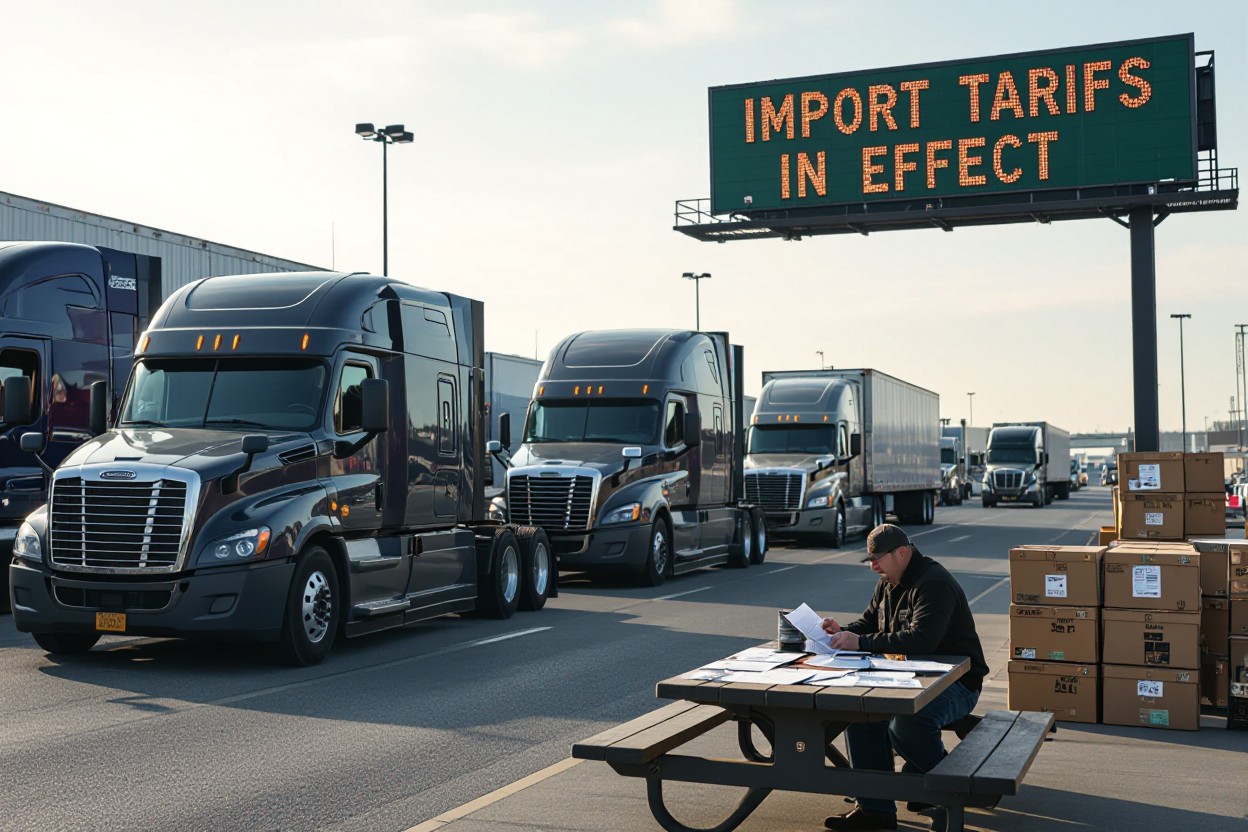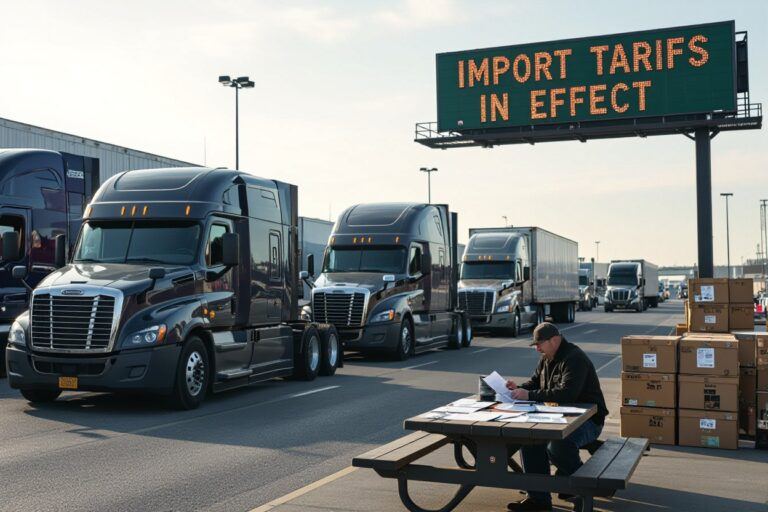
Sesquipedalian as that opener may be, I examine how tariffs change freight flows and what you and your fleet should expect: immediate cost pressure on fuel, parts and imported trucks that squeezes margins, shifting lanes and longer waits that create operational hazards, and the potential upside of increased demand for domestic haulage and pricing power. I lay out actions I use to protect revenue, streamline routing and advise on contract moves to shield your business.
Impact on Import and Export Rates
I analyze tariff shifts and how they alter import/export flows; when tariffs rise, I see import volumes fall and exporters face retaliation risks, which pushes freight backlogs and route changes. If you depend on cross-border loads, your lanes can tighten while domestic demand increases, creating price volatility that affects scheduling, capacity, and planning.
How Increased Costs Affect Trucking Operations
I monitor rising tariffs and pass-through costs that hit fuel, parts, and fees; I find carriers trimming routes, delaying maintenance, or raising rates. For your fleet this means tighter margins, potential driver layoffs or longer hours, and reduced service reliability. Conversely, higher freight rates can be a opportunity to renegotiate contracts and invest in efficiency.
I also warn that sustained tariffs can force you to change equipment cycles, delaying capital purchases or accelerating older trucks into service, which raises breakdown risks and safety hazards. I advise monitoring costs so you can use rate volatility to your advantage—locking in contracts when rates spike or pursuing backhaul opportunities to offset increased operating costs and protect margins.
Financial Stress on Independent Operators
I see tariffs drive up the cost of new trucks, replacement parts and imported supplies, and you often absorb those increases because you can’t raise rates quickly. That increased input cost and squeezed margin can push independents toward reduced maintenance, longer hours, or exiting the market, and the most dangerous outcome is insolvency when cash reserves run out; a positive counterpoint is that specializing in niche lanes can sometimes protect your revenue.
Strategies for Small Fleets to Navigate Tariff Challenges
I advise you to diversify freight lanes, negotiate index-linked rate clauses, use group purchasing for parts and fuel, and adopt telematics to cut idle time. Prioritize building a modest cash buffer and transparent fuel surcharges so your customers share volatility; diversification and contractual protection are the most positive moves, while failing to track costs is the most dangerous mistake.
I break strategies into operational, financial and commercial steps: operationally, use telematics and route optimization to lower fuel and maintenance spend and schedule preventative servicing to avoid expensive downtime; financially, set a transparent, index-based fuel surcharge and build a working capital cushion while being cautious with costly invoice factoring; commercially, renegotiate rate tables with escalation clauses, pursue diversified lanes and partner with other small fleets or buying co-ops to secure volume discounts. The most positive levers are contractual protections and shared purchasing, while the most dangerous outcomes come from underpricing, ignoring cost data, or dealing with predatory brokers that leave you exposed to insolvency.
The Ripple Effect on Diesel Prices
I monitor tariffs driving up import costs and I see how that pushes higher diesel prices at the pump, squeezing margins for you and your fleet. Tariffs can reduce supply of refiners’ inputs and create volatile spikes as futures react, meaning you face immediate fuel cost pressure and faster pass-through to freight rates.
Implications for Cost Management in Trucking
I tell operators to treat tariffs as an added fuel variable: hedging and fuel surcharges can blunt short-term blows while route optimization and tighter maintenance controls preserve margins. If you ignore sustained fuel shocks, your contracts and cash flow become dangerously exposed, so I prioritize flexible pricing and supplier clauses to protect your bottom line.
I also examine longer-term shifts: investing in telematics and driver training cuts fuel waste, while selective electrification and aerodynamic retrofits yield long-term savings that offset tariff-driven losses. I urge you to model scenarios, renegotiate fuel clauses, and maintain liquidity to withstand sustained price shocks without disrupting operations.

Potential Policy Changes and Their Effects
I assess that tariff hikes would push import costs higher, and I expect supply chain disruption and higher operating costs to squeeze margins for owner-operators and fleets. You may see freight rates rise, shippers shift sourcing, and market volatility increase. If policy favors domestic goods, there are opportunities for domestic freight, but I warn that policy uncertainty can trigger rapid cash-flow stress for drivers and small carriers.
Adaptation Strategies for the Trucking Industry
I recommend you diversify routes, renegotiate contracts with fuel and tariff clauses, and invest in fuel efficiency to protect margins; I also advise pooling loads and using data to lower empty miles. I know the risk of margin compression is real, so you should build cash buffers and cultivate direct shipper relationships that can absorb cost swings.
I dig deeper: I would prioritize technology that gives you real-time visibility so you can reroute around tariffs-driven bottlenecks and reduce demurrage; real-time routing and load-matching cut empty miles and protect cash flow. I suggest hedging fuel or adding fuel surcharges in contracts, because volatile input costs can rapidly erode earnings. You can form cooperatives or partnerships to share equipment and negotiate better rates, which is a positive way to stabilize income. For owner-operators I stress keeping a 90-day reserve and seeking diversified customers; for carriers, scenario planning for different tariff outcomes helps avoid sudden layoffs and service failures.

Testimonials on Navigating Tariff Impacts
I talk with drivers who adapt by cutting idle time and renegotiating rates; I see increased fuel and spare-part costs bite margins, and supply chain delays create dangerous schedule pressure for you. Some of your peers found new regional clients and shifted lanes to stay profitable, showing how nimble decisions can produce positive results even when tariffs squeeze rates.
Perspectives on Long-term Industry Changes
I analyze trends and tell you tariffs push fleets toward automation and network consolidation; I warn that labor shortages and rising equipment costs can be dangerous for small operators, while diversified service offerings may bring sustained revenue. I expect routes, alliances, and pricing structures to evolve, so your planning must balance investment risk with operational resilience.
When I look deeper, I see tariffs accelerating structural shifts: carriers invest in telematics and predictive maintenance to cut costs, and some merge to secure volumes. That makes automation and consolidation likely outcomes. For you, the dangers include higher capital burdens, fewer independent contracts, and tighter margins that can force older trucks off roads, increasing safety and compliance risks. The positive side is that specialized lanes, value-added logistics, and tech-enabled pricing can boost margins for adaptive operators. I advise monitoring policy signals, choosing targeted investments in fuel efficiency and training, and negotiating flexible contracts so your business can withstand tariff cycles without sacrificing safety.
Final Words
The impact of tariffs on truckers is multifaceted: I see higher costs, route changes, and scheduling pressure that reduce margins and increase stress; you face pass-through fees, delayed shipments, and volatile fuel and freight demand that undermine planning; your earnings and operational choices shift as carriers adapt to tariff-driven trade patterns, so policymakers and industry leaders must weigh these real-world consequences when crafting policy.



